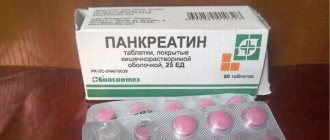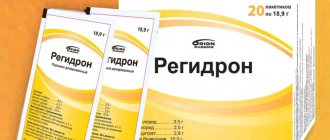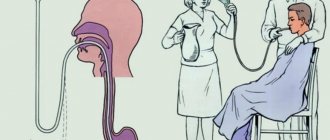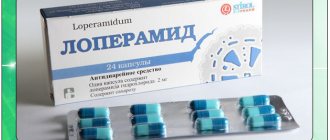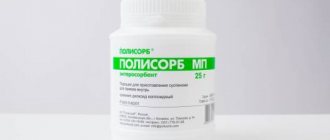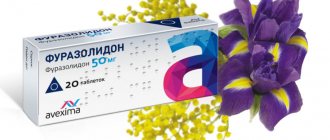An enema is a special medical procedure that cleanses the intestines . Even in the last century (since ancient times), this procedure was performed quite often for the purpose of cleansing the intestines and treating various ailments. But today such a procedure is carried out only in certain situations: before operations, in preparation for childbirth (with the woman’s consent), and also before some examinations. An enema is very effective for food or alcohol poisoning.
The essence of an enema for intoxication
An enema is performed for different purposes, so the procedure may differ in nature. There are cleansing enema, medicinal, oil, and hypertonic. In case of food or alcohol intoxication, a cleansing enema is performed , the purpose of which is to remove toxins from the body.
The need for this procedure arises if the process of diarrhea does not begin due to intoxication of the body. Diarrhea, as you know, is a natural reaction of the body to poisoning. With the help of loose stools and vomiting, the body independently cleanses itself of the effects of toxic substances. Accordingly, if there is no loose stool, then toxic substances will further poison the body, causing various disorders and complications in organs and systems. To prevent this, it makes sense to perform an enema.
Using a cleansing enema, a special solution (or plain clean water) is injected into the intestine. After the procedure, bowel movement occurs, as a result of which the injected medicinal liquid is removed from the body, and along with it all accumulated toxic substances. This measure cleanses the intestinal walls well and removes toxic compounds from the body.
The procedure is performed through the anus and without anesthesia; despite the fact that there should be no pain, patients often report severe discomfort. An enema is a fairly simple procedure, but it should be performed carefully. There is a special technique for doing it. It is even better if the enema is performed by an experienced doctor.
An enema for cleansing purposes should be performed after the gastric lavage procedure , which is also designed to rid the body of toxins.
When is an enema necessary?
When harmful substances enter the body, it tries to get rid of toxins using natural methods. First, vomiting occurs immediately after poisoning. After some time, diarrhea begins. Diarrhea occurs when toxins enter the intestines. When it is not possible to quickly remove poisons from the body, serious consequences develop in it. Severe intoxication can result in serious illness and even death. An enema helps save a person if it is done promptly and correctly.
Enema solution
To carry out an enema, solutions with different compositions are used. Experienced doctors use drug-based solutions for this, but it is not recommended to administer the medicinal liquid yourself, since unknowingly you can administer the wrong dose and ultimately cause even more harm. For safety reasons, it is better to use plain boiled water at room temperature for an enema at home , since everything that is introduced into the intestines necessarily enters the blood through the intestinal walls. Solutions with various additives are absorbed into the blood, and if intoxicated, their use can lead to negative consequences.
Main indications for the procedure
A person can cause poisoning accidentally or intentionally during a suicide attempt. The stomach cavity can be cleansed according to the following indications:
Food poisoning
- Food poisoning. 1–3 hours after taking expired or defective products, a deterioration in health begins: the person’s stomach swells, begins to feel sick, sweat appears on the forehead, weakness and vomiting occur.
- Chemical poisoning. In 8 out of 10 cases, children suffer; the remaining 20% are suicide attempts. In most cases, acids and alkalis are found in vinegar or household chemicals.
- Alcohol intoxication. If you abuse alcoholic beverages, take low-quality products or methyl alcohol, symptoms of poisoning may appear. Alcohol begins to be absorbed within 30 minutes, so first aid must be provided as quickly as possible.
- Intentional or accidental drug poisoning. In most cases, children may take medications by mistake. High dosage drugs are accidentally taken by older people in order to achieve a greater therapeutic effect.
- Mushroom poisoning. Refers to eating disorders. The toxin can be fatal.
- Stagnation of food in the stomach due to gastritis, pathologies of the nervous system and deformation. It develops against the background of impaired peristalsis of the smooth muscles of the organ or dystrophy of the glands that produce hydrochloric acid.
How to give an enema to an adult
The cleaning procedure is performed using a special tool called “Esmarch's Mug” . This tool consists of a heating pad (which is a mug), a rubber tube, and a set of tips.
You cannot carry out the procedure yourself. It is necessary for someone to help with this.
To help an adult cleanse the body of toxic substances, you must follow the following scheme:
- Pour about 2 liters of warm water into the heating pad (preferably, the temperature should be between 25-35 degrees), then release the remaining air from it using a tap and close tightly. The water for the procedure must be boiled, as it will be absorbed into the bloodstream through the intestinal walls. It is believed that the cooler the water, the more it will irritate the intestinal mucosa. But you should know that too cold water (18-20 degrees) can slow down the emptying process, so the optimal temperature in this case should be within 35 degrees.
- The mug must be suspended, so it must be fixed at a level of 1.5 meters. If this is not possible, then you can hold the mug in your hands.
- The victim must take a special position. To do this, he can lie on his left side with his knees bent or take a knee-elbow position.
- The enema is given through the anus, so you should lubricate the anus with any baby cream or Vaseline. The tip of the tool is also lubricated with a similar product.
- Next, you need to carefully and with rotational movements insert the tube to a depth of approximately 5-10 cm.
- Remove the clamp on the hose so that the liquid enters the intestines. It is necessary to ensure that the water does not enter the intestine very quickly, adjusting the speed using a tap. If the victim feels pain, it means that the intestines are filling too quickly with water. In this case, the fluid supply should be stopped to allow the victim to relax his stomach. Then continue the procedure with slightly less pressure.
- When the water is almost completely introduced into the intestine, the tap must be turned off and the tip slowly removed from the intestine.
- You can't have a bowel movement right away. The victim needs to lie in this position for some time (at least 10 minutes) to allow the fluid to be completely distributed in the intestines. Then you can safely go to the toilet.
The procedure should not cause pain, bloating or dizziness. If such symptoms occur, the procedure must be stopped.
According to the rules, an enema must be given after a natural bowel movement.
For those who experience frequent constipation, it is necessary to introduce half a liter of water and release it immediately to expel fecal impactions from the intestines. Then you can carry out the procedure according to all the rules. For constipation, a solution with the addition of vegetable oil or glycerin is often used . The oil solution envelops solid feces and facilitates its easy movement along the intestines. However, during intoxication of the body with toxic substances, this method is best used after consultation with a doctor.
Treatment of food poisoning
Hippocrates said that colon cleansing is one of the ways to take care of the colon. The intestines have a curved shape; in places where it bends, fecal stones accumulate, which do not come out naturally and continue to poison the body with toxins that are carried by the circulatory system. This slagging also leads to the growth of microbial pathogenic flora and parasites in the intestines, and their waste products increase the toxic load on the body.
As a result, over the years of increasing slagging, we lose strength, begin to get sick because our immunity from such intoxication is greatly reduced, and our skin and hair become dry and dull. And everyone calls this process aging, plus a lack of fluid dries out our body, and a large amount of work, stress, negative emotions and overeating wear it out.
Therefore, in addition to drinking fluids, proper nutrition and working on emotions, it is very important to regularly conduct cleansing enemas once a quarter. In what cases does an enema help? The injected liquid has a mechanical effect on the intestines, enhances its peristalsis, loosens feces, which helps with constipation, cleanses it, reducing the toxic load on the body; it is good for poisoning.
With dysbacteriosis, a condition when, as a result of poor nutrition, taking antibiotics, which by the way some meat products are stuffed with, and other negative factors, the balance of pathogenic microflora more than beneficial bacteria is disturbed. After washing and proper nutrition, beneficial microflora is quickly restored. Enema is contraindicated: for ulcers, inflammation, rectal fissures and hemorrhoids.
How to carry it out. The day before the enema, take 5 tablets of activated charcoal per 50 kg of body weight, which will absorb toxins like a sponge. The best time to spend it is morning or 20 pm. Clamping the tube, fill the Esmarch cup with liters of boiled water, at room temperature, hot water can increase the pressure, and also be absorbed into the intestines and not come out, hang up about 1.5 meters, I use a regular clothes hanger for this, as shown in the photo.
Wash the tip and lubricate it with oil. Take a knee-elbow dog position and begin to inject liquid, while relaxing your stomach and not squeezing. If you experience pain or discomfort, you can pull in your stomach, stroke it, or get distracted by counting. If there is torsion or the presence of adhesions in the sigmoid colon, you will have to administer 0.5 liters of water twice, and only then will it be possible to administer 2 liters at a time.
The enema was a success if upon completion you feel emptiness in your stomach and lightness in your body. What to do an enema with. You can add 1-2 teaspoons to the enema water:.
Avicenna performed enemas with chamomile, which has a beneficial effect on the mucous membranes. And in order to relieve bloating resulting from the temptation to eat unhealthy chocolate, I sometimes perform enemas with carbonated mineral water, although some sources prohibit this. What to do and how to eat. In order for bowel movements to be natural and regular, it is necessary to include porridge, gluten-free bran, fresh vegetables and fruits in the diet, and kefir contains bacteria that are beneficial to the intestines.
Walking, physical activity, massage, cold pouring water over the abdomen are necessary to improve blood circulation, remove clamps, and increase intestinal motility. All this will return strength to your intestinal muscles, and the enzymatic absorption ability of the mucous membrane. In addition to enemas, to cleanse the body, it is useful to carry out one-day fasting, a fasting day on fruit smoothies and anti-parasitic cleanses.
Take care of your intestines, and it will protect your health and youth! I also recommend that you read my following articles:. Thank you for attention! Sincerely! Elizaveta Grichan. Women's joys subscriber.
Good afternoon, many will be interested in understanding their health and their loved ones, and I will tell you my experience, and we will talk about How to give an enema if a child is poisoned.
Enema for a child
You need to give an enema to a child very carefully, since babies are more sensitive and can react very negatively to such a procedure. It is advisable that the enema be performed by a person with knowledge of the matter, for example, a doctor .
If children (especially newborns) are poisoned, you must immediately seek professional medical help. If the baby is poisoned by food, and help will not come soon, then the mother (or other responsible person) needs to independently perform an enema on the baby before the toxins have time to be completely absorbed into the blood.
For children, this procedure is done using a special rubber bulb, as well as boiled water, which must be at room temperature.
The volume of fluid depends on the age and weight of the child:
- up to 6 months, use liquid no more than 60 g;
- from 6 months to a year, no more than 150 g should be administered;
- from one to two years, use no more than 200 g of liquid;
- at the age of 2-5 years – no more than 300 g;
- at the age of 5-9 years - no more than 400 g;
- 10 years or more – half a liter.
Sequencing:
- The rubber bulb must first be boiled (about 30 minutes).
- Wash your hands thoroughly with soap.
- Place an oilcloth on the surface and then lay the baby on his back, placing a diaper under his bottom.
- Lubricate the tip of the rubber syringe with baby cream (you can also use Vaseline).
- Raise the baby's legs up (if the baby is over a year old, then lay him on his side and pull his legs towards his stomach).
- Fill the bulb with the prepared solution, and then squeeze out excess air.
- Carefully insert the tip into the baby's anus to a depth of no more than 3-4 cm (for older children, 6-8 cm is possible).
- Slowly introduce the prepared liquid into the intestines.
- Then slowly remove the tip of the bulb and then squeeze the baby's buttocks to retain water in the intestines.
- Let the child lie down for ten minutes, after which you can have a bowel movement.
It is advisable that during the enema someone help and calm the child if he is capricious . If the baby tolerated this procedure well, then the enema can be repeated, but if not, then wait for the help of doctors.
Danger of enema and contraindications
If the enema is performed incorrectly, additional troubles may arise. If the rules of the procedure are violated (as well as with frequent use of an enema), all beneficial microflora can be completely removed along with toxins .
In addition, trauma to the mucous membrane is possible, which sometimes leads to scarring and then malignant formations. An improperly performed enema can also lead to disruption of the normal functioning of the colon. It is also worth considering that in some conditions, an enema is contraindicated. These conditions include:
- chronic inflammatory bowel diseases in the acute stage (for example, proctitis, colitis, etc.);
- hemorrhoids with heavy bleeding;
- cracks in the anus;
- intestinal tumors;
- high body temperature;
- state of the body after strokes and heart attacks;
- pain in the abdomen.
If the poisoning is severe and requires urgent measures to cleanse the intestines, the decision on the enema procedure is made with a doctor .
When is rinsing not recommended?
There are a number of diseases for which enemas are prohibited:
- hemorrhoids in acute form (with bleeding);
- various intestinal diseases;
- female diseases (consultation with a gynecologist is required);
- acute pain in the abdomen.
By self-medicating and prescribing certain procedures, including enemas yourself, you can cause irreparable harm to the body. If you have any existing or past illnesses, you should consult a doctor.
The article was approved by the editors


